Acoustic horns - Study guides, Class notes & Summaries
Looking for the best study guides, study notes and summaries about Acoustic horns? On this page you'll find 42 study documents about Acoustic horns.
Page 3 out of 42 results
Sort by
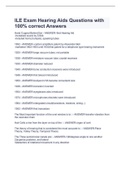
-
ILE Exam Hearing Aids Questions with 100% correct Answers
- Exam (elaborations) • 5 pages • 2023
- Available in package deal
-
- $9.99
- + learn more
Hand Cupped Behind Ear - ANSWER--first Hearing Aid -increased sound by 5-8db -included horns,trumpets, speaking tubes 1892 - ANSWER--carbon amplifiers patent by Alexander Bell -marketed 1902-1903 until 1930;first patent for a telephone type hearing instrument 1920 - ANSWER-large vacuum tubes; not portable 1938 - ANSWER-miniature vacuum tube ;crystal receivers 1930 - ANSWER-diameter reduced 1940 - ANSWER-bone conduction receivers were introduced 1946 - ANSWER-first telecoil i...
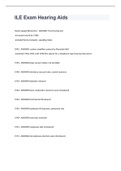
-
ILE Exam Hearing Aids 2022/2023 with 100% correct answers
- Exam (elaborations) • 7 pages • 2023
-
Available in package deal
-
- $8.49
- + learn more
Hand Cupped Behind Ear -first Hearing Aid -increased sound by 5-8db -included horns,trumpets, speaking tubes 1892 -carbon amplifiers patent by Alexander Bell -marketed 1902-1903 until 1930;first patent for a telephone type hearing instrument 1920 large vacuum tubes; not portable 1938 miniature vacuum tube ;crystal receivers 1930 diameter reduced 1940 bone conduction receivers were introduced 1946 first telecoil introduced 1950 bodyworn ...
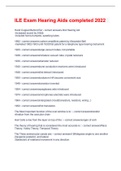
-
ILE Exam Hearing Aids completed 2022
- Exam (elaborations) • 5 pages • 2022
- Available in package deal
-
- $7.99
- + learn more
ILE Exam Hearing Aids completed 2022Hand Cupped Behind Ear -first Hearing Aid -increased sound by 5-8db -included horns,trumpets, speaking tubes 1892 -carbon amplifiers patent by Alexander Bell -marketed 1902-1903 until 1930;first patent for a telephone type hearing instrument 1920 large vacuum tubes; not portable 1938 miniature vacuum tube ;crystal receivers 1930 diameter reduced 1940 bone conduction receivers were introduced 1946 first teleco...
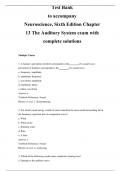
-
Neuroscience, Sixth Edition Chapter 13 The Auditory System exam with complete solutions
- Exam (elaborations) • 28 pages • 2024
-
Available in package deal
-
- $10.49
- + learn more
Test Bank to accompany Neuroscience, Sixth Edition Chapter 13 The Auditory System exam with complete solutions Multiple Choice 1. A human’s perception of pitch corresponds to the of a sound wave; perception of loudness corresponds to the of a sound wave. a. frequency; amplitude b. amplitude; frequency c. waveform; amplitude d. amplitude; phase e. phase; waveform Answer: a Textbook Reference: Sound Bloom’s Level: 1. Remembering 2. For which sound energy would a Fourier trans...

-
ZOOL 2403 Boros lecture exam 3 with 100% correct answers 2024
- Exam (elaborations) • 35 pages • 2024
-
Available in package deal
-
- $7.99
- + learn more
5 special senses - answer-olfaction, taste, vision, hearing, equilibrium and balance where is the olfactory pathway located? - answer-on the temporal lobe of the cerebral cortex what is the pathway of odor the olfactory cortex? - answer-odor goes to the olfactory receptors, pass through cribriform plate of ethmoid bone, CN I synapses on neurons in olfactory bulbs, whose axons form olfactory tract, and then goes to the olfactory cortex gustatory (definition) - answer-taste Where are t...
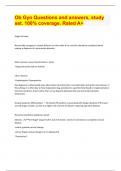
-
Ob Gyn Questions and answers, study set. 100% coverage. Rated A+
- Exam (elaborations) • 202 pages • 2023
-
- $12.49
- + learn more
Ob Gyn Questions and answers, study set. 100% coverage. Rated A+ Document Content and Description Below Ob Gyn Questions and answers, study set. 100% coverage. Rated A+ Stages of Labor Normal labor progress is slower before 6 cm than after 6 cm, and this should be considered when making a diagno sis of a protraction disorder. Most common cause of protraction / arrest -Hypocontractile Uterine Activity other reasons: -Cephalopelvic Disproportion this diagnosis is often based upon observation of ...
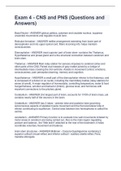
-
Exam 4 - CNS and PNS (Questions and Answers)
- Exam (elaborations) • 6 pages • 2022
-
- $9.99
- + learn more
Basal Nuclei - ANSWER globus palidus, putamen and caudate nucleus. suppress unwanted movements and regulate muscle tone. Reticular formation - ANSWER netlike arrangement extending from lower part of diencephalon and into upper spinal cord. filters incoming info. helps maintain consciousness Diencephalon - ANSWER most superior part of brain stem- contains the Thalamus, Hypothalamus and pineal gland and is the structural connection between cerebrum and brain stem. Thalamus - ANSWER Main r...
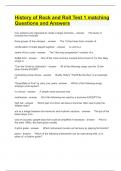
-
History of Rock and Roll Test 1 matching Questions and Answers
- Exam (elaborations) • 8 pages • 2024
-
Available in package deal
-
- $13.49
- + learn more
History of Rock and Roll Test 1 matching Questions and Answers how sections are organized to create a larger structure. The study of musical form includes three groups of four phrases. The 12-bar blues form consists of combination of notes played together. A cord is a series of four cords The "doo-wop progression" consists of a AABA form One of the most common musical forms found in Tin Pan Alley songs is "Can the Circle be Unbroken" All of the follo...
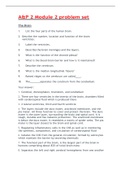
-
A&P 2 Module 2 problem set | 100% Verified Answers
- Exam (elaborations) • 20 pages • 2022
-
- $10.99
- + learn more
A&P 2 Module 2 problem set The Brain 1. List the four parts of the human brain. 2. Describe the number, location and function of the brain ventricles. 3. Label the ventricles. 4. Describe the brain meninges and the layers. 5. What is the function of the choroid plexus? 6. What is the blood-brain barrier and how is it maintained? 7. Describe the cerebrum. 8. What is the median longitudinal fissure? 9. Raised ridges on the cerebrum are called . 10. The separates the cerebrum from the cerebellum. Y...
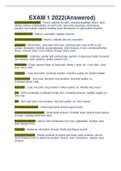
-
EXAM 1 2022(Answered)
- Exam (elaborations) • 12 pages • 2022
-
- $8.49
- + learn more
EXAM 1 2022(Answered) How to approach patient - Knock, address formally, meet/acknowledge others, learn names, ensure confidentiality, sit, don't rush, take notes sparingly, avoid typing, maintain eye contact, respect modesty, save discussions for after patient dresses Abdominal exam - Inspect, auscultate, palpate, percuss Exams except abdominal - Inspect, palpate, percuss, ausculate Inspection - Observation, uses eyes and nose, assesses gait, ease of ADLs, eye contact, demeanor, clot...

Do you wonder why so many students wear nice clothes, have money to spare and enjoy tons of free time? Well, they sell on Stuvia! Imagine your study notes being downloaded a dozen times for $15 each. Every. Single. Day. Discover all about earning on Stuvia


